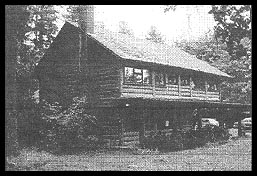Several years ago we acquired a log home built in 1903 approximately 35 miles south of Portland Oregon. In this series of articles spanning the next several newsletters we will cover the steps taken to evaluate, repair, restore and preserve this older log home. While we realize that most of you do not nor ever will own a log house quite like this we hope that you may find some of the information presented here of interest and use in maintaining your log home.

Step 1: Evaluation of the Site:
The home is located in an area with many mature trees. Two cedar trees tower above the house and a huge oak overhangs part of the roof. While these are not ideal situations the trees are so old and still very healthy so taking them down was out of the question. This will mean additional roof maintenance in the future however.
The site otherwise is perfectly acceptable. The ground slopes gently away from the house and it is quite dry under the house.
Step 2: Evaluation of the Structure:
Before us stood a hand-crafted log house with a 2-level main structure and a 1-level kitchen and shop wing added on at a later date. The use of two types of corner systems (piece-en-piece and round notching) were evident. The house was not scribe-fit so some sort of filler material was needed between many logs. The builders in this case opted for small saplings nailed into the gaps between courses of logs instead of a chinking material.
Rot – the house has plenty of it and with a little investigative work we were able to see why. Several conditions took place over the home’s lifetime to contribute to this unhappy situation:
- Vines. Peering in between the courses of logs we could see evidence of vine-like plant material indicating that a previous owner had allowed or even promoted the growth of a climbing vine up at least two sides of the house. While this may look romantic and charming log homes especially in our wet climate can not survive well with vines clinging to their sides. This vegetation holds moisture close to the logs and keeps them damp for extended periods of time. Rotting leaves from the vines can collect between the log courses and promote decay of the logs themselves.
- The sapling strips. Over time the nails loosened on these little strips and many pulled loose. Instead of helping seal out air infiltration they now actually channel rain down into the courses of logs. Repetitive moisture deep into the logs can easily promote rot.
- Paint. Instead of using a quality log home finish that allows moisture to escape while preventing additional moisture to penetrate the logs (i.e. letting the logs breathe) the past owners of the house applied paint. Most people think painting their house is a great protection from the elements but not for log homes-they do best with a log home finish as described above. In this case the paint acted as a barrier preventing the logs from expelling the excess moisture present due to the vegetation and saplings directing rain between the courses of logs. Imagine taking a very wet piece of wood and wrapping it in plastic film. Allow it to get nice and warm each summer for several years – will it decay? You bet!
- Roof problems. At some point in this house’s history a carport roof was attached to the existing roof line. Unfortunately the flat carport roof was situated below some very large cedar trees. The roofing was not flashed properly nor had it been swept clean for a very long time. Rain was able to seep between the house roof and the carport roof and drip down an entire wall of the shop both inside and outside. The bottom courses of logs have been damaged so much by this that they have actually crushed to some degree and are structurally unsound.
- Plumbing. Both the kitchen sink and tile shower are the culprits here. The kitchen sink is located at an exterior log wall and leaked into the log work for years before it was finally fixed. As a result the logs below the sink level have decay problems. Tile showers can be beautiful but they also have a bad reputation for leaking and this one was no exception. Not only were there cracks in the tile work in the floor of the shower but the shower had a continual drip. From the underside of the house we could see that the floor joists were completely decayed under the shower area.
- Foundation. The foundation was added after the home was built but no mud sill was installed. This has allowed water to penetrate between the concrete foundation walls and the lowest course of log work.
Okay so that about covers the main problems we saw with the structural aspect of the house. We also acknowledged that the wiring was out of date a new roof was needed interior walls and floors would need attention and the kitchen would need some modernizing.
Once we had most of the obvious problems on paper we had to weigh the potential finished product against the investment of time effort and money estimated to correct the problems. We decided the pros outweighed the cons and we forged ahead with the purchase. (Can you say that ’emotions’ had started to rear their ugly head into this project?).
Head to Part 2

